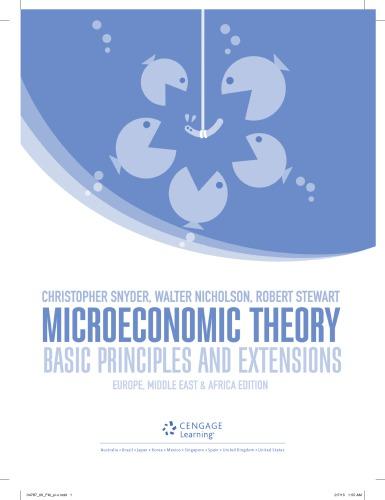2.14 More on expected value Because the expected value concept plays an important role in many economic
Question:
2.14 More on expected value Because the expected value concept plays an important role in many economic theories, it may be useful to sum marise a few more properties of this statistical measure.
Throughout this problem, x is assumed to be a continuous random variable with PDF f (x).
a.
(Jensen’s inequality) Suppose that g (x) is a concave function. Show that E
[g(x)] ≤ g[E
(x)].
Hint: Construct the tangent to g (x) at the point E(x). This tangent will have the form c + dx ≥ g(x) for all values of x and c + dE(x) =
g[E(x)] where c and d are constants.
b.
c.
d.
Use the procedure from part
(a) to show that if g (x)
is a convex function then E
[g
(x)] ≥ g
[E
(x)].
Suppose x takes on only non-negative values –
that is, 0 ≤ x ≤ ∞. Use integration by parts to show that
∞
E
(x) = 3
[1 − F
(x)]
d x,
0 where F (x) is the cumulative distribution func tion for x[that is, F(x) = ex 0
f
(t)d t].
(Markov’s inequality) Show that if x takes on only positive values then the following inequality holds:
P
(x ≥ t) ≤ E
(x)
t
.
Hint:
E(x) = e∞
0 xf
(x) d x = et 0
x f
(x) d x + e∞
t x
f
(x) d x.
e.
f.
Consider the PDF f (x) = 2x–3 for x ≥ 1.
1.
Show that this is a proper PDF.
2.
3.
4.
Calculate F(x) for this PDF.
Use the results of part
(c) to calculate E(x)
for this PDF.
Show that Markov’s inequality holds for this function.
The concept of conditional expected value is useful in some economic problems. We denote the expected value of x conditional on the occurrence of some event, A, as E(x ∣ A). To compute this value we need to know the PDF for x given that A has occurred [denoted by f (x ∣ A)]. With this notation, E (x∣A) = e+∞
−∞
xf (x∣A)
dx. Perhaps the easiest way to understand these relationships is with an example. Let f (x) = x 2 3 for −1 ≤ x ≤ 2.
1.
2.
3.
4.
5.
6.
Show that this is a proper PDF.
Calculate E(x).
Calculate the probability that −1 ≤ x ≤ 0.
Consider the event 0 ≤ x ≤ 2, and call this event A. What is f (x ∣ A)?
Calculate E(x ∣ A).
Explain your results intuitively.
Step by Step Answer:

Microeconomic Theory Basic Principles And Extensions
ISBN: 9781473729483
1st Edition
Authors: Christopher M Snyder, Walter Nicholson, Robert B Stewart






